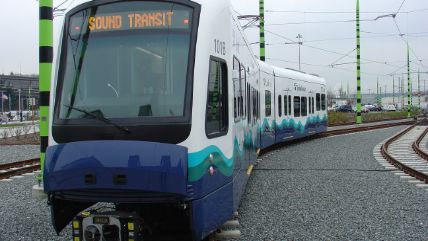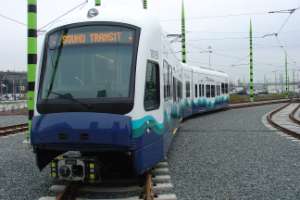Seattle Looks to Spend $54 Billion on Mass Transit System Few People Use
Sound Transit might not be sound policy.


At the Seattle bar and music venue Neamos last Tuesday, the usual entertainment of hair-gelled rock stars had to make room for Seattle Mayor Ed Murray and a string of other city officials.
The leaders were there for a launch party for Sound Transit 3 (ST3), a proposed $54 billion expansion of the Puget Sound area's transit system that will be voted on this November. According to the final plan, which was approved back in June, ST3 would buy commuters an additional 62 miles of light rail, new bus rapid transit lines, and expanded traditional bus services, all to be completed by 2040.
The objective of this staggering new investment is to cut down on highway congestion and make room for the estimated 800,000 new residents the Puget Sound metro area is expecting to attract in the coming decades. In addition, Murray has promised that light rail will also heal the environment and bring about racial justice in Seattle.
How will ST3 accomplish these glittering social goals? By providing 56,000–72,000 additional commuter trips a day. Mind you, this does not mean 56,000–72,000 additional commuters: A trip is defined by in the plan as one complete journey from origin to destination (say, from home to work). As most commuters will likely want to return from work at some point during the day, the number of new riders gained by that $54 billion is likely to be somewhere around half as high.
In fact, Mariya Kargopoltseva of the Washington Policy Center used Sound Transit's own projections and estimated that ST3 will net about new 28,147 riders. "This means that under ST3, each new transit rider will cost over $1 million dollars," she wrote. "It also means that 97% of the one million new residents expected in 2040 will likely not be using Sound Transit's costly services, meaning Sound Transit officials do not meet the demand for mobility they themselves anticipate."
And this assumes that ST3 remains in-budget and that its projected ridership scenario plays out. Given the agency's track record, neither should be taken for granted.
In 1996, when Seattle-area voters approved of a new light rail proposal, they were promised that the system would cost $2.3 billion and carry 105,000 daily riders by 2010. Instead, taxpayers ended up shelling out $5.3 billion, and the system was completed 10 years late and carries just one-third the number of riders expected.
Yet despite the high price tag and disappointing performance of previous light rail projects, ST3 has attracted widespread praise and support. Everyone from corporate titans Microsoft and Amazon to the ultra-leftists at The Stranger have touted its benefits, and their enthusiasm has translated into real money. Mass Transit Now, the official "yes" campaign, has attracted over $2 million in donations, much of it reportedly coming from unions and construction firms.
Meanwhile, opponents of the measure have raised a paltry $10,000. These donors, few that they are, might be better off saving their money for fare on what will likely become Seattle's newest boondoggle.
Rent Free is a weekly newsletter from Christian Britschgi on urbanism and the fight for less regulation, more housing, more property rights, and more freedom in America's cities.


Show Comments (76)